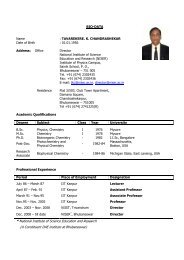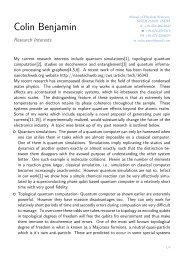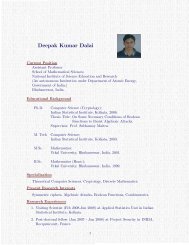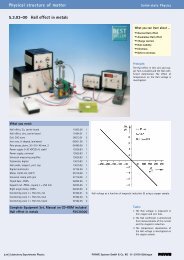Lecture-Notes (Thermodynamics) - niser
Lecture-Notes (Thermodynamics) - niser
Lecture-Notes (Thermodynamics) - niser
Create successful ePaper yourself
Turn your PDF publications into a flip-book with our unique Google optimized e-Paper software.
4.7. USEFUL COEFFICIENTS 35<br />
we cancel identical terms:<br />
and get<br />
<br />
∂U<br />
∂V T<br />
= T<br />
∂<br />
∂V<br />
<br />
∂P<br />
∂T V<br />
<br />
∂U<br />
=<br />
∂T<br />
∂U<br />
∂T∂V<br />
− P ⇒ energy equation. (4.5)<br />
In the energy equation, the derivative of the internal energy is written in terms of measurable<br />
quantities.<br />
Examples: for an ideal gas <br />
∂U<br />
∂V T<br />
= T nR<br />
V<br />
− P = 0,<br />
which means that the internal energy of the ideal gas is not dependent on its volume:<br />
Gay-Lussac experiment:<br />
4.7 Useful coefficients<br />
U = U(T) = CV T + const.<br />
U = 3<br />
2 NkBT → gas of monoatomic molecules,<br />
U = 5<br />
2 NkBT → gas of diatomic molecules.<br />
As<br />
<br />
we<br />
<br />
saw in the last section, the energy equation relates the experimentally inaccessible<br />
∂U<br />
∂V T to the experimentally accessible <br />
∂P<br />
∂T V . We will show now that <br />
∂P<br />
can be<br />
∂T V<br />
related to other thermodynamic coefficients as well. For that purpose, we will make use<br />
of the chain rule<br />
<br />
∂x ∂y ∂z<br />
= −1 ,<br />
∂y z ∂z x ∂x y<br />
(4.6)<br />
which can be derived by considering the differential of function f(x, y, z):<br />
df = ∂f ∂f ∂f<br />
dx + dy +<br />
∂x ∂y ∂z dz,<br />
<br />
∂x<br />
∂y<br />
<br />
∂y<br />
∂z<br />
z<br />
x<br />
= − ∂f/∂y<br />
∂f/∂x ,<br />
= − ∂f/∂z<br />
∂f/∂y ,







